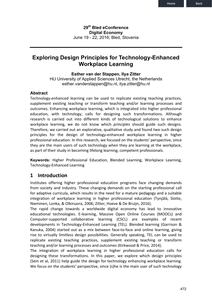From the article: "Abstract, technology-enhanced learning can be used to replicate existing teaching practices, supplement existing teaching or transform teaching and/or learning process and outcomes. Enhancing workplace learning, which is integrated into higher professional education, with technology, calls for designing such transformations. Although research is carried out into different kinds of technological solutions to enhance workplace learning, we do not know which principles should guide such designs. Therefore, we carried out an explorative, qualitative study and found two such design principles for the design of technology-enhanced workplace learning in higher professional education. In this research, we focused on the students' perspective, since they are the main users of such technology when they are learning at the workplace, as part of their study in becoming lifelong learning, competent professionals."
DOCUMENT

From the article: "The goal of higher professional education is to enable students to develop into reflective practitioners, having both a firm theoretical knowledge base as well as appropriate, professional attitudes and skills. Learning at the workplace is crucial in professional education, because it allows students to learn to act competently in complex contexts and unpredictable situations. Reflection on learning during an internship is hard to interweave with the working process, which may easily result in students having little control over their own learning process while at work. In this study, we aim to discover in what way we can effectively use technology to enhance workplace learning, by synthesizing design propositions for Technology- Enhanced Workplace Learning (TEWL). We conducted design-based research which is cyclic in nature. Based on preliminary research, we constructed initial design propositions and developed a web-based app (software program for mobile devices) providing interventions based on these propositions. In a pilot study, students from different educational domains used this app to support their workplace learning. We evaluated the initial design propositions by carrying out both a theoretical and a practical evaluation. With the insights obtained from these evaluations, we developed a next version of the design propositions and improved the app accordingly. The research result is a set of design propositions for TEWL. For daily practice, the developed web-based app is available for re-use and further research and development."
DOCUMENT

Communication plays an important role in manyprofessional contexts. This is especially truefor students in the field of social work. Theaim of this study was to develop formative,self-regulated multimedia self-assessment ofsocial-communicative competencies for socialwork students. First, a pilot study wasconducted to gain insight into the students'specific characteristics. This insight was usedto design guidelines for the development of theassessment instrument in order to tune these tothe students' perceptions, instructionalpreferences, and personalities and thusenhancing the students' enthusiasm to use theself-assessment instrument. This might increasethe chance for successful implementation ofthis new form of assessment. A first version of a multimedia test wasdeveloped. A quality expert meeting wasorganised to gain insight into expertjudgements on the quality of the test and toobtain indications for improvement of theassessment. A second version of the test wasconstructed and put on the Internet. Nearly 400students completed the assessment and expressedtheir opinions on this new way of communicationassessment. We found it was possible to testsocial-communicative competence by means ofmultimedia, with the help of digital video. Theuse of Internet makes assessments available atany time to fit curriculum needs and alsoresolves time and space constraints. Ourconclusion was that the multimedia test isreasonably valid. All students reported havingliked the multimedia assessment.
LINK